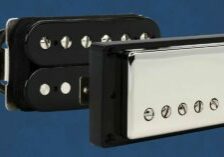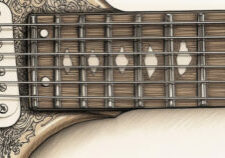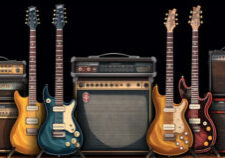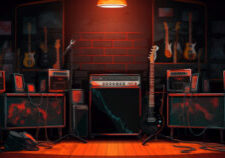Guitar and bass amps may look similar on the outside, but they have some key differences that affect their performance and suitability for each instrument. While there are some cases where you can use the same amp for both guitar and bass, it’s almost always better to use an amp designed for bass or guitar.
Generally, a guitar amp is optimized to emphasize the midrange frequencies produced by an electric guitar’s pickups, while a bass amp is designed to handle the low frequencies produced by a bass guitar’s strings. This means that if you were to plug a bass into a guitar amp (or vice versa), you would likely get a muddy or distorted sound due to the mismatched frequency response. So, if you want to get the best possible tone from your instrument, it’s crucial to choose an amplifier that’s built for it specifically.
Key Takeaways
- Bass amps emphasize low-end frequencies, while guitar amps accentuate mid-range frequencies
- Bass amps often have more control over lower frequency ranges and feature larger speakers
- Guitar amps utilize tubes and speakers to accentuate natural tone and typically offer more variety in built-in effects
- Choosing the appropriate amp based on musical needs and preferences is crucial for enhancing overall sound quality.
Understanding the Basics of Amplifiers
Understanding the basics of amplifiers can be helpful in distinguishing between a bass amp and a guitar amp. The history of amplifiers dates back to the early 1900s when vacuum tube technology was used to amplify sound signals. Over the years, there have been significant advancements in amplifier technology, leading to modern-day solid-state and digital amplifiers.
Guitar amps are tailored to produce higher-frequency sounds from electric guitars compared to bass amps. Guitar amps typically come equipped with more tone-shaping features such as reverb, distortion, and equalizers that allow players to modify their sound. While bass players can use effects, they are normally not needed on the amp.
Differences in Sound Frequency
When it comes to amplifiers, the differences in sound frequency between bass and guitar amps are significant.
Bass amps are designed to emphasize low-end frequencies, giving your bass guitar a powerful, deep sound that cuts through any mix.
On the other hand, guitar amps accentuate the natural tone of your instrument by boosting mid-range frequencies and providing a more dynamic range of sounds.
Understanding these key differences can help you choose the right amplifier for your needs and achieve the perfect sound for your performances or recordings. It is extremely important that each instrument lives in their “frequency range.” This is often referred to as “sitting in the mix.”
Emphasis on Low-End Frequencies for Bass Amps
You’ll feel the bass rumbling through your bones when you plug into a proper bass amp. Bass amps are designed to emphasize these low bass tones, creating a full and powerful sound.
The emphasis on low frequencies is achieved through a combination of equalization techniques and speaker placement. Equalization techniques allow for fine-tuning of different frequency ranges to create the desired tone. Bass amps typically have more control over the lower frequency ranges than guitar amps, allowing for greater flexibility in shaping the overall sound. In addition, bass amps often feature larger speakers that can handle the lower frequencies without distortion or loss of clarity.
Proper speaker placement also plays an important role in achieving optimal low-end response from a bass amp. Placing the amp on the floor or close to a wall can help enhance the bass response by taking advantage of nearby surfaces to reflect and amplify low frequencies. However, it’s important to be mindful of how this positioning affects other aspects of your sound, such as midrange clarity and overall volume levels.
Accentuation of Natural Tone for Guitar Amps
The natural tone of a guitar is essential to its sound. Guitar amps utilize high-quality tubes and speakers to accentuate this tone, providing a warm and rich sound that musicians love. Tonal variations can be achieved by adjusting amplifier settings, such as gain, EQ, and volume.
Amplifier settings can help bring out the best in a guitar’s natural tone. For example, changing the gain setting can affect the level of distortion or overdrive produced by the amp. Tweaking the EQ controls can enhance certain frequencies while attenuating others to create a customized sound. Volume control can also be used to manipulate the dynamics and overall impact of your performance.
Wattage
When it comes to wattage, it’s important to know that bass amps typically have a higher wattage than guitar amps. This is because bass frequencies require more power to produce the same volume as guitar frequencies.
Higher Wattage in Bass Amps
Here are some reasons why higher wattage is important for bass amps:
- Better headroom: Higher wattage provides more headroom, which means that your amp can handle sudden spikes in volume without clipping or distorting.
- Increased volume: With a higher wattage, you’ll be able to play louder without sacrificing tone quality.
- Deeper lows: Bass frequencies require more power to produce, and a higher wattage ensures that you get deeper, fuller lows.
- Improved dynamics: High-wattage bass amps respond better to changes in playing dynamics, allowing you to express yourself more fully as a musician.
- Longer lifespan: If you plan on using your amp regularly or gigging frequently, investing in a high-wattage bass amp will ensure that it lasts longer and performs better over time.
Lower Wattage in Guitar Amps
While many guitarists may think that bigger is always better when it comes to amplifiers, smaller amps can actually offer some distinct advantages.
One major benefit of lower wattage in guitar amps is portability. Smaller amps are easier to lug around and set up for gigs or practice sessions, making them a great choice for musicians who need to travel frequently or have limited space in their homes.
Additionally, lower-wattage amps tend to be more affordable than high-powered models, which can make them an attractive option for beginners or hobbyists on a budget. When it comes to tone, there are also some unique differences between lower-wattage tube amps.
One thing to note is that solid-state amplifiers are generally going to be higher wattage than tube amps but that doesn’t mean they are louder. For example, a 15W tube amp may produce the same decibels as a 50W solid-state amp.
The guitar amp can get away with lower power. However, if you go too low, you may not be loud enough to stand out when playing live. This can be a big problem with a loud, heavy metal band or even just a loud drummer.
Depending on the amp you might be able to go as low as 15W or 20W and still be loud enough to play live and cut through the mix. This depends on the amp and your signal chain. Normally 40W is a safe zone that should be able to play with any band.
Speaker Size
When it comes to speaker size in amplifiers, there are significant differences between bass amps and guitar amps.
Bass amps typically have larger speakers than guitar amps, which allows them to handle the lower frequencies produced by bass guitars.
On the other hand, guitar amps usually have smaller speakers that provide a more focused sound for the higher frequencies of electric guitars.
Larger Speakers in Bass Amps
With larger speakers, bass amps are able to produce a deeper and more powerful low-end sound compared to guitar amps. The benefits of larger speakers in bass amps include an increase in the amount of air moved by the speaker, resulting in a more robust sound with greater volume. The impact on sound quality is significant as the larger size allows for greater accuracy and clarity in reproducing low-frequency tones.
However, there is a trade-off between portability and power when it comes to bass amps with larger speakers. As the size of the speaker increases, so does the weight of the amplifier overall. This can make transporting it from one location to another difficult for some musicians who need to travel frequently or play gigs at multiple venues.
I prefer 15-inch speakers in a bass amp. Just feel like it gives me that booming sound. If you prioritize power over portability, then a bass amp with large speakers might be just what you need to fill a room with deep, rich tones that shake your audience’s bones!
Smaller Speakers in Guitar Amps
Although guitar amps with smaller speakers may lack some of the power and depth that larger speakers provide, they do offer a more compact and lightweight option for musicians on the go. In terms of speaker efficiency, smaller speakers are designed to produce higher frequencies more effectively than larger ones. This means that while bass amps require larger speakers to handle low-end frequencies without distortion, guitar amps can get away with using smaller ones since most guitars produce sound in the mid-range.
However, tonal clarity is a crucial aspect to consider when choosing a guitar amp. Smaller speakers tend to have less tonal clarity compared to their larger counterparts. This is because they are not able to reproduce the full range of frequencies as accurately as bigger speakers. Therefore, it’s important for guitarists to find a balance between portability and tonal quality when selecting an amp with smaller speakers.
For the most part, its very common for guitar amps to have 12-inch speakers and it’s the speaker size I prefer for guitar. There are some great amps with 10 inch speakers like the legendary Fender Super Reverb which is a 4×10 and sounds incredible. In the end, use your ears to decide.
Tube vs. Solid State Power
Tube amplifiers, also known as valve amplifiers, have been around since the early days of audio technology. They utilize vacuum tubes to amplify the audio signal. One of the notable features of tube amps is their warm and rich sound. They tend to produce a pleasing and harmonically rich tone that guitarists love. Tube amps are known for their ability to provide smooth and dynamic tonal nuances, with a natural compression that adds a touch of warmth and character to the music.
Solid-state amplifiers have gained popularity due to their efficiency, reliability, and affordability. Unlike tube amps, solid-state amps use transistors and other solid-state components to amplify the audio signal. These amps are known for their clarity, accuracy, and high fidelity. Solid-state amps generally have a more transparent and precise sound reproduction, making them suitable for genres that require a more clean and detailed sound.
Both guitar and bass amps can work with tube amps or solid-state power amps. A very large percentage of guitarists prefer a tube amp because of the natural distortion sound. Since many bass players prefer a clean sound or they like to use pedal distortion. This opens the door to using solid-state amps. I only use solid-state bass amps because I think they sound better and they are less expensive.
Cost
If you’re looking to purchase a bass amp or guitar amp, cost is definitely a factor to consider. While there are affordable options out there, it’s important to keep in mind that the quality of sound may vary depending on the brand and price range.
Guitar amp cost covers the entire spectrum. For playing at home, you can find decent amps for under $200 if you buy used. There are some great amps that sell in the $400-$700 range that are fantastic for home use but still loud enough to gig with. Then the $1000+ area really can get you an outstanding amp and models that are used by professional musicians.
Bass amps can get expensive but I find that its easier to find amazing deals on bass amps on the used market under $200. I picked up a 1980’s Ampeg for $50 at a pawn shop that is a pure gem that sounds brilliant and has been used in a live setting.
Ultimately, when considering affordability for your bass or guitar amp purchase, it’s important to weigh not just the upfront cost but also the long-term value. A cheaper option may save you money initially but could end up costing more in repairs or replacement down the line. Consider factors like durability and warranty when making your decision.
Summary: Guitar amps vs. Bass amps
With so many options out there, you can get completely lost trying to pick an amp. To summarize, here is what you need to consider.
- A bass amp that uses solid-state power for more affordable but still sounds fantastic
- Tube amps are heavy but they really sound fantastic for a guitar player
- If you plan to play live, try to get an amp over 40W.
- 12 inch guitar speakers tend to be the most common with a nice balance of sound
- 15 inch bass speakers tend to be the most common and ideal to get the booming bass sound
- Portability is a factor to consider, especially if you getting older like me.
Take time to research and test out different amps before making your decision.
One piece of advice is that investing in quality equipment can greatly enhance your overall playing experience. I have solid almost every cheap amp I’ve bought over the years, so if you plan to play guitar for many years to come, don’t buy cheap gear.





